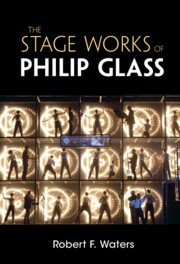Book contents
- The Stage Works of Philip Glass
- The Stage Works of Philip Glass
- Copyright page
- Dedication
- Contents
- Figures
- Tables
- Music Examples
- Selected Stage Works of Philip Glass
- Preface
- Acknowledgments
- Part I Background
- Part II Stage Works
- Chapter 5 Theater
- Chapter 6 Language and Philosophy
- Chapter 7 Themes, Genres, and Archetypes
- Chapter 8 Multimedia and Hybrid Genres
- Chapter 9 Dance
- Chapter 10 Music
- Chapter 11 Critical and Audience Reception
- Chapter 12 Conclusion
- Notes
- Select Bibliography
- Index
Chapter 10 - Music
from Part II - Stage Works
Published online by Cambridge University Press: 21 July 2022
- The Stage Works of Philip Glass
- The Stage Works of Philip Glass
- Copyright page
- Dedication
- Contents
- Figures
- Tables
- Music Examples
- Selected Stage Works of Philip Glass
- Preface
- Acknowledgments
- Part I Background
- Part II Stage Works
- Chapter 5 Theater
- Chapter 6 Language and Philosophy
- Chapter 7 Themes, Genres, and Archetypes
- Chapter 8 Multimedia and Hybrid Genres
- Chapter 9 Dance
- Chapter 10 Music
- Chapter 11 Critical and Audience Reception
- Chapter 12 Conclusion
- Notes
- Select Bibliography
- Index
Summary
Glass’s early works composed between 1967 and 1975 feature rhythm as the primary structural principle, while containing cyclical constructions adapted from Indian music. Glass recalled his early experiences with Indian music: “I [then] thought I was listening to music that was built in an additive way, but it turned out it really wasn’t. It was built in a cyclic way … In Indian music (and all the non-Western music with which I’m familiar), you stake small units, or ‘beats,’ and string them together to make up larger time values. For my whole generation, which was dominated by serialism, this music was a breath of fresh air. It allowed us to think of music in a different way.” Glass combined this approach with additive and subtractive elements commonly associated with minimalist technique. In the mid- to late 1970s, Glass began to combine rhythmic elements with drones and slow harmonic rhythm, the latter influenced not only by Indian music but also by the modal jazz of hard-bop saxophonist John Coltrane. Glass also included chromatic side-stepping in many of his works, a technique used by Debussy and other composers in the early twentieth century. In addition, Glass employed tonal–modal hybrid constructions that sounded harmonically and melodically enigmatic.
- Type
- Chapter
- Information
- The Stage Works of Philip Glass , pp. 171 - 184Publisher: Cambridge University PressPrint publication year: 2022



